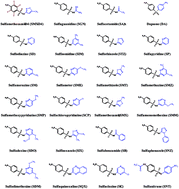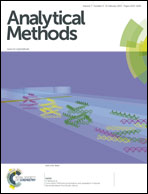A multi-residue analysis of sulphonamides in edible animal tissues using QuEChERS extraction and HPLC-MS/MS†
Abstract
A HPLC double reaction monitoring MS/MS method was developed for the determination of a wide range (>20) of sulphonamide residues in several edible animal (sheep, pork, beef, chicken and dromedary) tissues. Sample preparation was based on the simultaneous extraction into acetonitrile solution followed by a clean-up using primary secondary amine beads. Quantification was carried out using matrix-matched calibration curves. The limit of detection (LOD) and limit of quantification (LOQ) ranged from 0.5 to 14.5 μg kg−1 and from 1.8 to 48.4 μg kg−1, respectively. The decision limit (CCα) and decision capability (CCβ) obtained were below 100 μg kg−1 for sulphonamides and below 5 μg kg−1 for dapsone. The method was validated in terms of recoveries and inter- and intra-day precision by reference analyses of meat samples using LC-Orbitrap MS and by the analysis of a reference material. The method was applied to the analysis of several animal tissue samples collected in Lebanon. The highest values were observed for sulfamethazine and sulfadimethoxine at 70.2 and 62.5 μg kg−1 in sheep tissues.


 Please wait while we load your content...
Please wait while we load your content...